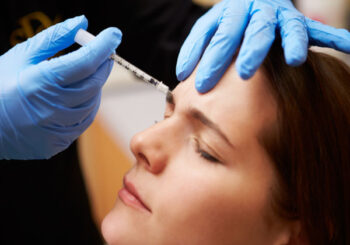By Sayer Ji
Contributing writer for Wake Up World
Botox is a strange creature. Currently the only FDA-approved treatment to “temporarily make moderate to severe frown lines, crow’s feet, and forehead lines look better in adults,” it carries with it stern warnings about serious, even life-threatening side effects, as posted on its manufacturer Allergan’s website:
- Problems swallowing, speaking, or breathing, due to weakening of associated muscles, can be severe and result in loss of life. You are at the highest risk if these problems are pre-existing before injection. Swallowing problems may last for several months.
- Spread of toxin effects. The effect of botulinum toxin may affect areas away from the injection site and cause serious symptoms including: loss of strength and all-over muscle weakness, double vision, blurred vision and drooping eyelids, hoarseness or change or loss of voice, trouble saying words clearly, loss of bladder control, trouble breathing, and trouble swallowing.
These adverse effects seem like an exceptionally high price to pay for the promise of only temporary improvements in natural signs of aging. Also, given these side effects, its approval by the FDA clearly defies the most fundamental medical ethical principle, espoused since its Hippocrateon inception in the West, namely, “first, do not harm.”
No doubt, its ever-expanding popularity, fueled by its widespread adoption by celebrities, is contributing to the minimization of safety concerns.
It doesn’t help the situation that mainstream tabloids like Time Magazine uncritically laud it’s benefits, as with it’s Jan. 2017 cover article on “How Botox Became a Drug That Could Treat Everything,” claiming it can treat 800 different conditions. With this kind of free advertising, it is no wonder that global sales of Botox hover around three billion a year. But with the increasing popularity of an ostensibly cosmetic intervention whose mechanism of action is the destruction of nerves, it behooves us to shed light on the unintended, adverse effects of this pharmaceutical product.
Botox’s Underreported Toxicity Examined
On a strictly physical level of action, it is now known that botulinum toxin can travel rapidly beyond the site of injection directly to the central nervous system. Science Daily reported on this finding recently: Botox makes unnerving journey into our nervous system: “New research might bring a frown to even the most heavily botoxed faces, with scientists finding how some of the potent toxin used for cosmetic surgery escapes into the central nervous system.”
Proponents of Botox claim the amount of botulinum toxin administered is far too low to cause safety concerns. But the margin of error when it comes to safety is exceptionally hard to determine with botulinum toxin because it is the most potent neurotoxic substance known. In fact, it only takes 75 billionths of a gram (75 ng) to kill a person weighing 75 kg (165 lbs). It has been estimated that only 1 kilogram (2.2 lbs) would be enough to kill the entire human population. Different people have varying degrees of susceptibility to botulinum toxin, which makes it even harder to apply a one-size-fits all toxicological risk model to it.
Indeed, rare but nonetheless catastrophic side effects to the central nervous system have been reported around the world. The issue received national attention in 2007 when Allergan was ordered to pay a Virginia man 212 million dollars from damage caused by their product. In Jan. of 2008, Public Citizen, representing 100,000 consumers world wide, filed a petition to the FDA titled, “Petition Requesting Regulatory Action Concerning the Spread of Botulinum Toxin (Botox, Myobloc) to Other Parts of the Body,” asking the FDA to immediately require botulinum manufacturers Allergan and Solstice Neurosciences to issue warning letters to physicians regarding all botulinum-containing formulations. A year later the FDA granted their petition and required the manufacturers to put the following ‘black box’ warning on their products:
While this consumer warning is progress in the right direction, it does not address what may just be the far more subtle yet widespread problem of Botox-induced psychological, emotional, and perhaps even spiritual side adverse effects.
The manufacturer recommends injecting this toxin directly into the Procerus muscle, which is within the neurobiological locus of the ‘third eye.’ Could this do more than paralyze the nerve/muscles in that area, and affect cognition, emotion and intution? In Chinese acupuncture this point is known as the Yin Tang, or “Hall of Impression,” and is known as an “extraordinary point,” i.e. it stands on its own by not being part of any particular meridian, and is sometimes interpreted as associated with intuition and inner visions.
Consider what we have only recently learned about the ‘water’ additive fluoride, which has been linked to enhanced calcification of the pineal gland — the neurobiological locus of the ‘third eye’ — and which can deaden our awareness, IQ, and ability to appreciate the nuances of the human condition. Another example is Tylenol, used at the rate of billions of doses a year, around the world, which has been found to have profound, adverse psychiatric side effects: namely, flattening human affect and deadening empathy.
Also, when you look at the clearly body dysmorphic images of those who have undergone the procedure, countless times, it may not be that great a stretch to consider whether these injections are affecting if not warping the mind.
Perhaps this locus of the soul has been implicated by multiple sources of toxicity: The water supplement, fluoride, has been linked to enhanced calcification of the pineal gland and has documented potential to lower can IQ. Another example is Tylenol, used at the rate of billions of doses a year, around the world, which has been found to have profound, adverse psychiatric side effects: namely, flattening human affect and deadening empathy.
Beyond physical side effects: Can Botox affect human interactions?
It turns out that a growing body of peer-reviewed, clinical research show how Botox injections affect more than just the physical surface of the facial musculoskeletal and nervous system, but change how the human brain responds to emotional situations, as well as aspects of cognition and the processing and understanding of language itself. In other words, the damage done by Botox injections directly and perhaps profoundly affects and alters human consciousness.
The following 6 studies offer clinical evidence supporting this claim:
- A 2009 study titled, “The link between facial feedback and neural activity within central circuitries of emotion–new insights from botulinum toxin-induced denervation of frown muscles,” found that Botox treatment reduced the activation of the left amygdala and its functional coupling with brain stem regions implicated in autonomic manifestations of emotional states.
- A 2010 study titled, “Cosmetic use of botulinum toxin-A affects processing of emotional language, reveals that Botox-induced blocking facial expression by peripheral denervation of facial musculature selectively hinders emotional language processing.
- A 2011 study titled, “Embodied Emotion Perception,” found that Botox injections dampened emotion perception by interfering with muscular feedback from the face, effectively interfering with their ability to empathize.
- 2014 study titled, “Botulinum toxin-induced facial muscle paralysis affects amygdala responses to the perception of emotional expressions: preliminary findings from an A-B-A design, ” found that Botox affects emotional experience by interfering with the feedback signals from facial muscles. Specifically, Botox interfered with amygdala activity, a part of the brain’s limbic system associated with memory, survival instinct, and emotions in general.
- A 2014 study titled, “Altered cortical activation from the hand after facial botulinum toxin treatment,” found that Botox-induced loss of facial movements alters the cortical circuits involved in processing tactile inputs from the hand. The researchers concluded: “This suggests that the limited paralysis of facial muscles induced during cosmetic interventions designed to smooth lines and wrinkles on the face is sufficient to alter the cortical processing of tactile inputs from the hand.”
- 2016 study titled, “Deeper than skin deep – The effect of botulinum toxin-A on emotion processing,” found that emotional stimuli were blunted after Botox use, and that they became slower at categorizing emotional facial expressions under time pressure.
?The implications of this research are highly concerning. Millions of people have likely experienced emotional and cognitive changes from these injections, the risks of which they were not informed, nor consented to.
Botox Alters Consciousness By Disrupting Facial Feedback
So, what is the mechanism behind the aforementioned phenomenon of Botox-induced emotional blunting and reduced empathy? The most likely explanation is based on the facial feedback hypothesis which states that skeletal muscle feedback from facial expression plays a causal role in regulating emotional experience and behavior. It was actually Charles Darwin who was the first known to propose this:
“The free expression by outward signs of an emotion intensifies it. On the other hand, the repression, as far as this is possible, of all outward signs softens our emotions.”
This hypothesis first found compelling clinical substantation in 1976 where participants had lower skin conductance and pain (subjective ratings) when hiding the painfulness of the shocks , compared with those in the study who openly expressed pain. Add to this the six studies above, and it is undeniable that Botox’s effects go far deeper than the skin.
Your Body is Your Biography: Careful What You Edit/Delete
Biology is biography. Using Botox to alter or erase the physiognomic text of the face we can now see will have emotional/cognitive consequences that may impact perception and behavior. Perhaps we need to remember that while wrinkles today have become medicalizable signs of pathology against which FDA-approved nerve-destroying treatments are liberally applied, they are also signs of character and perhaps wisdom, reflective of another kind of beauty — the soulful kind. As Clarence Day once said,
“Age should not have its face lifted, but it should rather teach the world to admire wrinkles as the etchings of experience and the firm line of character.”
In this sense, the artificial ‘youthfulness’ produced by Botox is far from beautiful.
To learn about natural ways to reverse premature aging of the skin use the GreenMedInfo database on Aging:
About the author:
Sayer Ji is the founder of Greenmedinfo.com, a reviewer at the International Journal of Human Nutrition and Functional Medicine, Co-founder and CEO of Systome Biomed, Vice Chairman of the Board of the National Health Federation, and Steering Committee Member of the Global Non-GMO Foundation.
© 2020 GreenMedInfo LLC. This work is reproduced and distributed with the permission of GreenMedInfo LLC. Want to learn more from GreenMedInfo? Sign up for their newsletter here.

If you've found value in our articles, we invite you to support the release of our brand-new book, "Gratitude Practices for Kids: A Practical Guide for Adults to Instill a Spirit of Appreciation and Positivity in the Next Generation."
"Gratitude Practices for Kids" brings together over 25 innovative and accessible practices designed to enhance gratitude in everyday life. This comprehensive guide is backed by 17 scientific studies, ensuring each concept is grounded in research, underscoring our commitment to nurturing growth, emotional intelligence, and positive interactions between adults and children.
We encourage you to opt for the paperback version to celebrate this new release. Dive into its fresh pages away from digital distractions, allowing you to immerse yourself in the transformative practices it offers.
Over recent years, Wake Up World has faced significant online censorship, which has impacted our financial ability to operate. Moving into book publishing represents a strategic step to secure the ongoing funds needed to continue our mission. By purchasing Gratitude for Kids, you help us keep our content free and accessible to everyone, avoiding needing a paywall. With over 8,500 articles published in the last 13 years, we remain dedicated to keeping our valuable content open to all.










